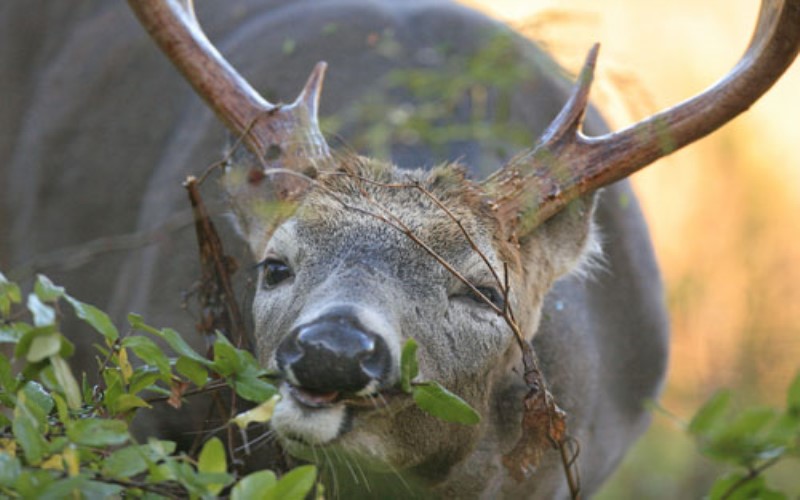Deer are one of the most iconic animals in North America. They have been a staple of the North American landscape for centuries, with their majestic antlers and graceful movements. While it is easy to admire their beauty and elegance, deer are now running out of food options in the wild. Therefore, we must understand what deer eat to keep them properly nourished.
Deer are herbivores, meaning that they primarily eat plants and vegetation. The deer’s diet depends on the species, the season, and the region, as different vegetation types may be more or less available. However, some of the most common items that deer eat include grass, leaves, twigs, buds, bark, fruits, and nuts.
Typical Deer Diet
Mast
Mast describes the edible fruits and nuts produced by trees and shrubs. It is an integral part of the diet of deer, especially during the fall and winter months when other food sources are less accessible. Deer can consume various mast, including acorns, beechnuts, hickory nuts, walnuts, and other nuts and fruits.
The nutritional value of mast varies between species. For example, acorns are a high-energy food source for deer because they are rich in carbohydrates and fats, while hickory nuts provide protein and fat without carbohydrates. Meanwhile, beechnuts offer more protein than acorns and provide phosphorus and magnesium. Walnuts are higher in carbohydrates than most other types of mast and are a good source of calcium and magnesium.
Deer have evolved and can digest various types of mast and absorb the nutrients they need from these foods. This evolution is a necessary adaptation that allows them to survive during the winter when food sources are limited. This also makes it easier for you to adequately feed them mast throughout the winter months.
Forbs
Forbs are broad-leaved, herbaceous plants that provide an essential food source for deer. They are usually found near bodies of water and in moist, grassy areas. Deer can consume various forbs, including clover, plantain, dandelion, and many others.
Forbs provide a high-quality food source for deer, with a high-energy content and various essential nutrients. They are an important source of carbohydrates, proteins, minerals, and vitamins. Forbs are also high in fiber, which helps to keep deer healthy and helps them to digest their food.
They are vital food sources during the spring and summer, when other food sources may be scarce or inaccessible. Deer can consume large amounts of forbs during these times, which helps them to stay healthy and provides them with the energy they need to survive.
Browse
Browse is the term used to describe the leaves, twigs, buds, and other parts of trees and shrubs that deer consume. These items are an important part of a deer’s diet, providing them with various essential nutrients such as carbohydrates, proteins, minerals, and vitamins therightmessages.
Browse is a significant food source for deer during the winter when other food sources are scarce or inaccessible. Deer can consume large amounts of browse during these times, which helps them to stay healthy and provides them with the energy they need to survive the cold period.
Browse is a good source of protein and essential fatty acids for proper growth and development. Deer can digest the cellulose in the browse, which helps them to extract the nutrients they need from this food source.
Grass
The grass is an important food source for deer, as it is a high-energy food source that is rich in carbohydrates, proteins, minerals, and vitamins. Deer can consume various types of grass, including fescue, ryegrass, and timothy. However, most deer prefer switchgrass and ryegrass over other styles.
Grasses are an essential food source during the spring and summer, when other food sources may be scarce or inaccessible—grass sprouts in spring and winter when it is shiny and warmer, and its availability nourishes deer. Specifically, grass rises earlier after winter than other deer food sources, which compels deer to feed on this source as other foods mature.
The grass is also a good source of fiber, which helps to keep deer healthy and helps them to digest their food. In addition, grass is a good source of calcium and magnesium, essential for proper bone and teeth development mynoteworld.
Fungus
Fungus is an integral part of the diet of deer, as it provides them with a variety of essential nutrients such as carbohydrates, proteins, minerals, and vitamins. Deer can consume different fungi depending on the time of year and their geographic location. Some favorites include boletes, brittlegills, morels, ringstalk mushrooms and waxycaps.
Fungus is a vital food source during the fall and winter when other food sources have withered and just begun to sprout. Deer consume fungi in this period to avoid starvation as the other food sources become scarce in winter tvboxbee.
Fungus is also a good source of essential fatty acids for proper growth and development. Deer can digest the cellulose in fungus, which helps them extract the nutrients they need from this food source.
Supplementing with Food Plots
Food plots are small areas of land planted with various food sources specifically designed to attract and support wildlife. Food plots are typically planted with grains, legumes, and other crops to provide a reliable food source throughout the year. Hunters and landowners often use them to attract, hold, and keep deer on the property for hunting.
Food plots are an essential part of successful wildlife management. They provide a reliable food source while improving the habitat’s quality. With the correct hunting plot supply and proper management practices, food plots can be an effective and cost-efficient way to attract and hold wildlife for hunting.
Let’s Feed The Deer
Deer are a part of the North American landscape. Understanding what deer eat and how to provide them with a balanced diet is essential for survival in the wild. Deer primarily consume grasses, leaves, twigs, bark, fruits, and nuts, depending on the season. Food plots are essential in providing deer with a balanced diet in areas where food sources are scarce. These recommendations can help you establish an outstanding food plot in your backyard FAQ BLOG.

